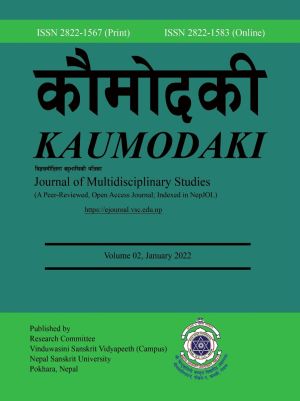Exploration of Tragic Soul in Abhijnanashakuntalam
DOI:
https://doi.org/10.3126/kdk.v2i1.42876Keywords:
Karuna rasa, Pathos, shringar rasa, tragedyAbstract
This article explores the tragic tones in Abhijnanashakuntalam (AS) from Aristotelian theory of tragedy. As per this theory, characters confront obstacles, external or from within. It contains characteristics like hamartia, catharsis, consistency, etc. AS too contains all those characteristics. So, this paper explores how Shakuntala confronts tragedies as Aristotle propounds. Karuna rasa suffuses over AS because the farewell scene of Shakuntala predominantly consists of this rasa. The malfeasance and injustices she meets in Dushyanta’s court further justify the pathos in the play. Thus, the concept of tragic soul dominates throughout the play. The West comes to know the dramatic composition of Kalidasa more after William Jones’ translation of AS into English in 1789. The hero and the heroine in it accept their ill fates, dib ‘ring’ as a source of their long separation. The coupling of the two gives a chirpy ending to the play, but the soul of it is full of commiserations. In Sanskrit, the ‘curse’ is one of the agencies evolving into a tragedy. Numerous reviewers and commentators make a study of AS, a drama chiefly of Shringar rasa or the sentiment of love. However, this paper finds it predominantly a drama of pathos or Karuna rasa. To explore these issues, this article applies the qualitative approach to the research. It is exploratory.
Downloads
Downloads
Published
How to Cite
Issue
Section
License
This license enables reusers to distribute, remix, adapt, and build upon the material in any medium or format for noncommercial purposes only, and only so long as attribution is given to the creator.




